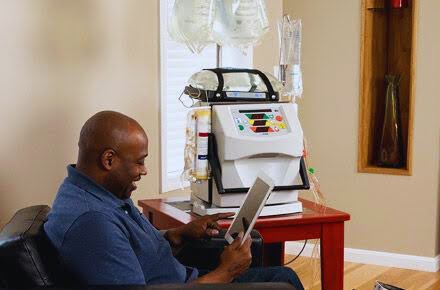Home vs. In-Center Dialysis: Which Treatment Option Is Right for You?
10/02/2025
If you or a loved one has been diagnosed with chronic kidney disease (CKD) or end-stage renal disease (ESRD), you may be wondering which type of dialysis is right for you.
Dialysis is a life-sustaining treatment that helps remove excess fluid, toxins, and waste products from the blood when the kidneys can no longer function properly. In the U.S., nearly 786,000 people live with ESRD, and about 558,000 of them rely on dialysis to survive, according to the National Institute of Diabetes and Digestive and Kidney Diseases (NIDDK).
Choosing between home dialysis and in-center dialysis is a major decision that impacts your health, lifestyle, and overall well-being.
Types of Dialysis: Home vs. In-Center
Dialysis is a treatment that removes waste, toxins, and excess fluid from the blood when the kidneys are no longer able to do so effectively. There are two main types of dialysis, each with different methods of filtering the blood:
- Hemodialysis (HD) – This method uses a dialysis machine and a special filter called a dialyzer (artificial kidney) to clean the blood. Blood is drawn from the body, passed through the dialyzer, and then returned to the bloodstream. Hemodialysis can be performed in a dialysis center (in-center dialysis) or at home (home hemodialysis).
- Peritoneal Dialysis (PD) – Instead of using a machine, PD relies on the lining of the abdomen (peritoneum) and a special cleansing fluid called dialysate to remove waste. The fluid is introduced into the abdomen through a catheter, absorbs waste from the blood, and is then drained out. This type of dialysis is done exclusively at home and requires residual kidney function for optimal effectiveness.
1. In-Center Hemodialysis (Traditional Facility Dialysis)
- Performed at a dialysis clinic under the supervision of a nephrologist and dialysis care team.
- Typically scheduled three times a week for about 3–5 hours per session.
- Uses a dialysis machine and dialyzer to filter waste from your blood.
- Requires traveling to a dialysis center multiple times a week.
- A dialysis care team, including nurses and technicians, assists with treatment.
- Often results in larger fluid shifts, which may cause fatigue, dizziness, or muscle cramps after sessions.
According to the Centers for Disease Control and Prevention (CDC), in-center dialysis patients have a higher risk of bloodstream infections due to repeated needle insertions and exposure to hospital-based germs.
2. Home Hemodialysis (Home HD)
- Performed in the comfort of your own home with the help of a trained care partner or independently (for some patients).
- Can be done more frequently (5–7 times a week), offering short daily hemodialysis or nocturnal home hemodialysis (longer sessions overnight while you sleep).
- Provides gentler treatment with better control over fluid removal, leading to fewer dietary and fluid restrictions.
- Requires training and space for equipment but allows more independence and flexibility.
- Reduces the risk of hospital-related infections compared to in-center dialysis.
A study from the National Kidney Foundation (NKF) found that frequent home dialysis leads to:
- Lower blood pressure with fewer medications
- Better heart health and fewer complications
- Improved survival rates compared to standard in-center dialysis
Key Benefits of Home Hemodialysis
Many dialysis patients prefer home hemodialysis over in-center dialysis because it offers:

- More flexibility—Dialysis can be done at home on your own schedule.
- better health outcomes—Frequent dialysis helps remove more waste and excess fluid, keeping blood levels stable.
- Fewer dietary and fluid restrictions—Patients can often drink more fluids and eat a less restrictive diet.
- Greater independence—No need to rely on transportation to a dialysis center.
- Lower infection risk—You’re not exposed to germs and infections in a busy dialysis unit.
A 2021 study in the Clinical Journal of the American Society of Nephrology (CJASN) found that home hemodialysis patients had a 20-25% lower mortality rate compared to those receiving in-center dialysis.
Which Dialysis Option is Right for You?
Choosing between home hemodialysis (HHD) and in-center dialysis impacts your lifestyle and health. While both provide life-sustaining treatment, home hemodialysis offers more flexibility, better health outcomes, and greater independence.
Key Factors to Consider
- Medical Condition – Patients with severe heart disease may require in-center care, but home HD provides gentler, more frequent treatment that improves heart health.
- Lifestyle Preferences – Home HD allows flexible scheduling, while in-center dialysis requires fixed appointments three times a week.
- Support System – A care partner helps, but many patients successfully perform solo home dialysis after training.
- Training Commitment – Home HD requires learning to operate the machine, but the benefits include better energy, fewer restrictions, and improved well-being.
Insurance Coverage and Support
Most dialysis treatment options, including home and in-center dialysis, are covered by Medicare, Medicaid, and many private insurance plans.
Explore dialysis insurance coverage and what’s included
Understanding your insurance benefits can help you make a confident, informed decision about the best dialysis option for your needs.
Next Steps: Talk to Your Nephrologist
Choosing a dialysis treatment is a significant decision. The Division of Nephrology at your healthcare provider can help assess your individual needs.
Whether you choose in-center hemodialysis, nocturnal home hemodialysis, or frequent daily home dialysis, the goal is to maintain the best possible health and quality of life.
If you’re considering home dialysis, talk to your doctor today to see if it’s the right option for you.
Frequently Asked Questions
Yes, home hemodialysis offers more flexibility, better health outcomes, and fewer dietary restrictions compared to in-center dialysis.
Home dialysis requires training, space for equipment, and a care partner (if needed), but many patients successfully manage it independently.
Home hemodialysis provides more effective toxin removal, better blood pressure control, and fewer infection risks compared to peritoneal dialysis.
Peritoneal dialysis requires a permanent abdominal catheter, has a higher risk of infection (peritonitis), and is less effective for patients with severe kidney failure.

Dr. Allen Kaufman is the Chief Medical Officer and Senior VP for Clinical & Scientific Affairs at Dialyze Direct, with over four decades of experience in Nephrology. He began his career in 1980 and has held leadership roles including Chief of Nephrology & Hypertension at Beth Israel Medical Center (1998–2004), Chief of Dialysis at the Bronx VA Medical Center (1982–1990), and Chief of the Yorkville Dialysis Unit at Beth Israel and the Renal Research Institute (1990–2000). Dr. Kaufman has authored over 100 scientific publications and served as Principal or Co-Investigator on numerous NIH-funded research studies. A Fellow of the American College of Physicians, he is board-certified in Nephrology and Internal Medicine. He earned his medical degree from the University of Rochester and completed training at the Hospital of the University of Pennsylvania and Mount Sinai in New York. Dr. Kaufman is widely recognized with multiple “Best Doctor” and “Patients’ Choice” awards.